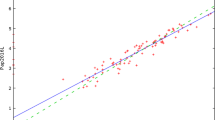Abstract
Consider a country's national output, measured by counting the number of authors from countryc that collaborate in every paper in a bibliography. Depending on whether countryc appears at least once in every paper, we are able to deduce the corresponding relationship betweenc's fractional score and its fraction of multinational papers to whichc belongs.
One of these models, a slowly decreasing concave function is similar to the relation observed byNederhof andMoed 1 between the fractionated score of a countryc and its fraction of multinational papers.
The proof of the models developed here uses a stochastic property of weighting schemes, namely that the average fractional score of a country equals its total score.
Similar content being viewed by others
References
Nederhof, A. J., Moed, H. F., Modeling multinational publication: Development of an on-line fractionation approach to measure national scientific output,Scientometrics, 27 (1) (1993) 39–52.
Cole, J. R., Cole, S.,Social Stratification in Science. Chicago: the University of Chicago Press (1973).
Schubert, A., Glänzel, W., Braun, T., Scientometric datafiles. A comprehensive set of indicators on 2649 journals and 96 countries in all major fields and subfields 1981–1985.Scientometrics, 16 (1989) 3–478.
Egghe, L., Rousseau, R.,Introduction to Informetrics. Quantitative Methods in Library, Documentation and Information Science, Amserdam: Elsevier, (1990).
Price, D. De Solla, Letter to the editor.Science, 212 (1981) 987.
Van Hooydonk, G., Fractional counting of multi-authored publications: consequences for the impact of authors,Journal of the American Society for Information Science, 48 (1997) 944–945.
Egghe, L., Rousseau, R., Van Hooydonk, G., Methods for accrediting publications to authors or countries: consequences for evaluation studies. Preprint, (1998).
Chow, Y. S., Teicher, H.,Probability Theory. Independence, Interchangeability, Martingales, New York, Springer Verlag, (1978).
Author information
Authors and Affiliations
Rights and permissions
About this article
Cite this article
Egghe, L. An explanation of the relation between the fraction of multinational publications and the fractional score of a country. Scientometrics 45, 291–310 (1999). https://doi.org/10.1007/BF02458438
Received:
Issue Date:
DOI: https://doi.org/10.1007/BF02458438




